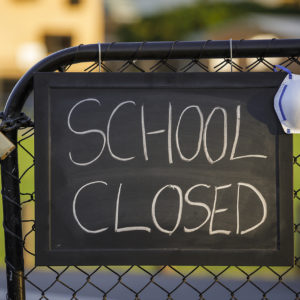American schoolchildren just suffered the worst test-score setback ever recorded, yet another disastrous result of the nation’s misguided COVID lockdown policy.
Data released by the National Center for Education Statistics (NCES) show that in the latest assessment of 13-year-old students, average math scores dropped 9 points, and average reading scores fell 4 points — all in just two years.
For the lowest-performing students, scores haven’t been this bad since the 1970s when the “Long-Term Trend (LTT) Age 13 Reading and Mathematics” assessment began.
Recent NCES testing of fourth- and eighth-grade students picked up a similar trend.
“The system created with the aspiration of being the ‘great equalizer’ has, in fact, become the great divider,” said Commissioner of Education Frank Edelblut. “Although the losses were steeper in math than in reading, it is clear that students need significant support in both areas, particularly since reading had been flat or declining since before the pandemic and long-term scores have been falling for about a decade.”
The trend may go back a decade, but it collapsed into a freefall when classrooms were locked down in response to the COVID-19 pandemic. Things went from bad to worse when schools remained closed for more than a year (in some states, two years) under pressure from teachers unions and their political allies.
At the same time, states like Florida ordered their schools to reopen for the Fall, 2020 semester. Florida just had their highest NAEP test score results in state history.
In New Hampshire, many public schools didn’t reopen for five-day-a-week, in-person education until forced to by Gov. Chris Sununu on April 19, 2021. That was 13 months after the pandemic began and at least six months after overwhelming evidence confirmed that schools were safe for students during COVID-19.
As early as July 2020, reports were laying out data on the extremely low health risks to children from COVID and the terrible impact of closed classrooms — particularly for low-income families and students of color.
Union leaders Megan Tuttle of the NEA-NH and Deb Howes of the AFT-NH both led efforts resisting school reopening starting in Fall 2o2o. They also opposed Sununu’s mandate that teachers and students return to the classroom in 2021. Tuttle compared teachers returning to classrooms to first responders like police officers and EMTs as part of her push to keep kids at home in front of Zoom calls.
Asked about the latest test scores and whether they had any regrets regarding the consequences of the closed classroom, both declined to respond.
One indicator in the new data that classroom closures are the culprit for lower test scores is the difference in declines between public and private school students. For public school students, test scores fell a full 10 points, compared to 4 points in private schools.
Stanford’s Center for Research on Education Outcomes (Credo) released its latest report tracking charter-school outcomes, including in 2023, last week. The study covered more than two million charter students in 29 states.
“The comparisons in some states are more remarkable,” reports The Wall Street Journal. “In New York, charter students were 75 days ahead in reading and 73 days in math compared with traditional public-school peers. In Illinois, they were 40 days ahead in reading and 48 in math. Those differences can add up to an extra year of learning across an entire elementary education.”
Not all of that overperformance occurred beginning in 2020, and not all charter schools had the same COVID-19 protocols. But charter schools were less likely to lock down and more likely to be locked down for shorter periods of time.
In all the data released in the past week, there is a similar trend: Black and Brown students trapped in public schools with closed classrooms suffered some of the worst learning losses. At the same time, their counterparts of color in charter schools either equaled or surpassed the performances of their fellow students.
“While these results might paint a bleak picture, we must act with urgency and leverage the Nation’s Report Card to see where more resources outside of the classroom setting might be needed to accelerate learning and help students be prepared to pursue their educational, career and life goals,” Edelblut said.
What he didn’t say, but is obvious, is that one of the most effective “resources outside the classroom” is the Education Freedom Account program that allows low-to-moderate income families to take their funding to the right school for their students.
The teachers unions and their allies have been just as adamant about shutting down the EFA program as they were about keeping kids at home on Zoom calls.
Test scores don’t lie. Can the advocates for classroom closing say the same long after the science was against thee?



